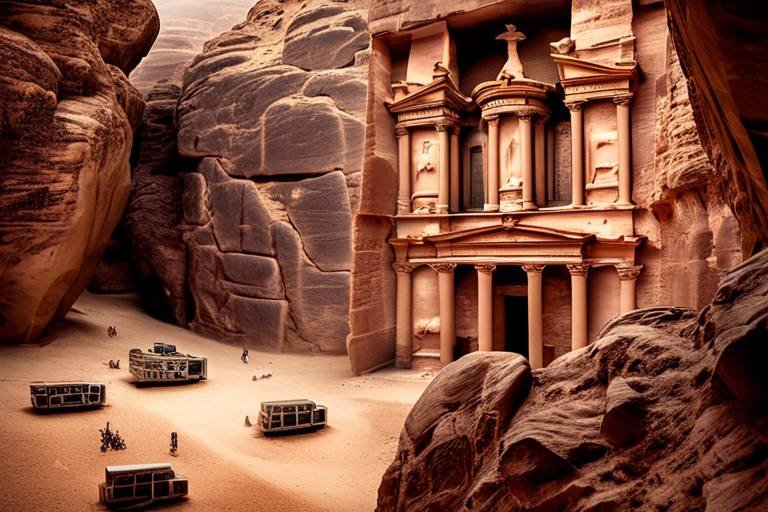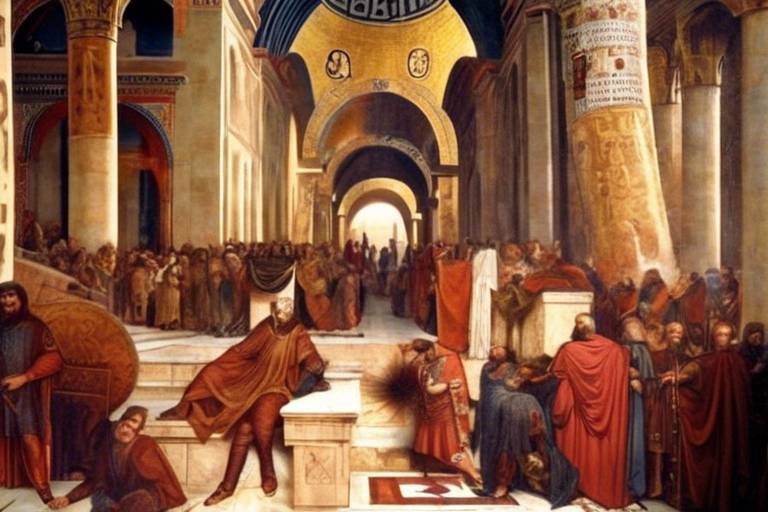The Enigma of the Lost City of Petra
The Lost City of Petra, nestled in the heart of Jordan, stands as a testament to the enigmatic allure of ancient civilizations. Carved into rose-red cliffs, this archaeological marvel beckons visitors to unravel its mysteries and bask in its grandeur. Petra's history dates back to the Nabateans, a civilization shrouded in intrigue and sophistication.
As you wander through the narrow Siq, a natural rock fissure leading to the city, you can't help but marvel at the historical significance of Petra. Once a bustling trading hub, Petra served as a crossroads for caravans transporting precious goods across vast distances. The intricate rock-cut architecture is a testament to the ingenuity of its creators, showcasing a blend of artistry and practicality.
The geological marvel of Petra lies not only in its man-made structures but also in the natural formations that surround it. The towering cliffs, striated with vibrant hues, create a dramatic backdrop for the ancient city. The interplay between human craftsmanship and geological wonders makes Petra a truly unique destination for history enthusiasts and nature lovers alike.
Excavations and archaeological discoveries at Petra continue to unveil glimpses of the past, offering insights into the daily lives and customs of its former inhabitants. From intricate tombs to ancient water systems, each finding adds a layer of complexity to the narrative of Petra's past, painting a vivid picture of a bygone era.
Legends shroud the lost city of Petra, fueling speculation about the mysterious disappearance of its people. Stories of trade routes, hidden treasures, and sudden abandonment weave a tapestry of intrigue around this ancient metropolis. The enigma of Petra's past invites us to ponder the secrets buried within its sandstone walls.
The iconic Treasury building, with its intricate facade carved into the rock face, stands as a symbol of Petra's architectural prowess. Monuments scattered throughout the city, such as the Monastery and the Royal Tombs, showcase the grandeur and sophistication of Nabatean craftsmanship, leaving visitors in awe of the city's past glory.
Preserving Petra's fragile structures amidst a growing wave of tourism poses a significant challenge. Balancing conservation efforts with the need to accommodate visitors requires careful planning and sustainable practices. The delicate balance between heritage preservation and tourism development is crucial to ensuring Petra's longevity for future generations.
Modern exploration techniques, including LiDAR scanning and ground-penetrating radar, offer new avenues for uncovering hidden secrets within Petra's ruins. Advanced research methods provide archaeologists with tools to delve deeper into the mysteries that lie beneath the surface, shedding light on undiscovered facets of Petra's history.
The cultural impact of Petra extends far beyond its ancient walls, resonating as a UNESCO World Heritage Site and a symbol of Jordan's rich heritage. The site serves as a bridge between the past and the present, connecting visitors to a legacy of art, architecture, and innovation that continues to inspire awe and wonder.

Historical Significance
Exploring the mysteries and wonders surrounding the ancient archaeological site of Petra in Jordan, known for its rock-cut architecture and fascinating history dating back to the Nabatean civilization.
Nestled within the rugged landscapes of Jordan lies the enigmatic city of Petra, a place steeped in historical significance that transcends time. Dating back to the 4th century BC, Petra served as a vital trading hub, connecting the East and West through its strategic location along ancient caravan routes. The city's architectural marvels, carved into rose-red cliffs, stand as a testament to the ingenuity of the Nabatean civilization, showcasing their mastery of rock-cut architecture and water management systems. Petra's rich history unfolds like a captivating story, each monument whispering tales of a bygone era filled with trade, culture, and innovation.
Delving into the heart of Petra unveils a geological marvel unlike any other. The city's rose-red sandstone cliffs, sculpted by nature's patient hand over millennia, create a mesmerizing backdrop for the ancient ruins. From the towering rock formations to the narrow siq that leads to the Treasury, Petra's landscape is a masterpiece of nature's artistry. Walking through the ancient city, one can't help but marvel at the harmonious blend of human craftsmanship and natural beauty, a symphony of earth and stone that echoes through the corridors of time.
Excavations in Petra continue to unearth a treasure trove of archaeological discoveries, offering glimpses into the daily lives and customs of its past inhabitants. From intricate pottery fragments to ancient inscriptions, each find adds a new layer to the complex tapestry of Petra's history. The ongoing research sheds light on the city's economic prosperity, religious practices, and social structures, painting a vivid picture of a vibrant civilization that thrived in the heart of the desert.
Legends shroud Petra in an aura of mystery, with tales of its mysterious disappearance and eventual abandonment captivating the imagination. Some believe that the city's inhabitants vanished without a trace, leaving behind only whispers in the wind. The enigmatic fate of Petra adds to its allure, inviting speculation and sparking curiosity about the secrets buried within its sandstone walls.
At the heart of Petra stands the iconic Treasury, a breathtaking facade carved into the cliff face, adorned with intricate details and mythical figures. This architectural masterpiece is just one of many awe-inspiring monuments that dot the landscape, each bearing witness to Petra's grandeur and cultural sophistication. From the Royal Tombs to the Great Temple, these monuments stand as silent sentinels of a civilization long past, beckoning visitors to marvel at their timeless beauty.
As Petra's fame spreads far and wide, the challenges of balancing tourism with conservation loom large. The delicate sandstone structures face threats from erosion, foot traffic, and environmental factors, prompting efforts to preserve this ancient wonder for future generations. Sustainable tourism practices and conservation initiatives aim to protect Petra's fragile heritage while ensuring that visitors can experience its magic in a responsible and respectful manner.
In the age of technology, modern explorers are harnessing advanced tools and research methods to unlock the secrets hidden within Petra's ancient ruins. Ground-penetrating radar, drones, and 3D mapping techniques offer new perspectives on the city's layout and structures, revealing hidden chambers and undiscovered treasures buried beneath the sands of time. Each new discovery adds another chapter to Petra's story, reshaping our understanding of this enigmatic archaeological site.
Petra's cultural impact transcends borders, earning it the prestigious status of a UNESCO World Heritage Site and a symbol of Jordan's rich history and heritage. The city's enduring legacy resonates with visitors from around the globe, drawing them into a world of ancient wonders and timeless beauty. Petra stands as a testament to human creativity and resilience, a beacon of hope that illuminates the path to understanding our shared past and shaping our future.

Geological Marvel
Petra, often referred to as the "Rose City," is not only a historical treasure trove but also a geological marvel that captivates visitors with its stunning natural features. Nestled in the rugged mountains of southern Jordan, Petra's unique landscape is a testament to the forces of nature that have shaped it over millennia.
One of the most striking geological formations in Petra is the Siq, a narrow canyon that serves as the main entrance to the ancient city. As visitors walk through this winding passage flanked by towering cliffs, they are enveloped by the sheer magnitude of the rock walls that rise hundreds of feet above them. The Siq's natural beauty, with its intricate patterns and hues of red and orange, creates a dramatic prelude to the grandeur that awaits within Petra.
Carved into the rose-colored sandstone cliffs are a myriad of rock-cut tombs, temples, and dwellings that showcase the ancient Nabateans' architectural prowess. The intricate facades of these structures, adorned with elaborate carvings and decorative elements, stand as a testament to the symbiotic relationship between human creativity and the natural landscape.
One of the most iconic features of Petra is the Treasury, a monumental building hewn directly into the rock face. Its intricate design and elaborate ornamentation, including columns, friezes, and statues, exemplify the fusion of artistry and geology that defines Petra's allure. The Treasury's sheer size and intricate details leave visitors in awe of the ancient craftsmen who sculpted this architectural masterpiece.
Moreover, the geological formations within Petra are not just visually stunning but also hold clues to the region's ancient past. The layers of sedimentary rock, shaped by millions of years of geological processes, provide valuable insights into the area's geological history and environmental evolution. By studying these formations, geologists can unravel the mysteries of Petra's geological past and gain a deeper understanding of the forces that shaped this ancient city.
In conclusion, Petra's geological marvels, from the towering cliffs of the Siq to the intricate rock-cut architecture, form an integral part of the site's allure and mystique. The interplay between nature and human ingenuity has created a landscape that continues to fascinate and inspire visitors from around the world, making Petra a truly unique destination that defies both time and imagination.

Archaeological Discoveries
Exploring the mysteries and wonders surrounding the ancient archaeological site of Petra in Jordan, known for its rock-cut architecture and fascinating history dating back to the Nabatean civilization.
As archaeologists delve into the sands of time at Petra, a treasure trove of discoveries awaits, shedding light on the daily lives and customs of the ancient inhabitants. Through meticulous excavations and careful analysis, researchers have unearthed a plethora of artifacts that offer a glimpse into the past.
Among the remarkable findings are intricately carved pottery, ancient inscriptions, and remnants of dwellings that provide insight into the architectural prowess of the Nabateans. These discoveries not only reveal the artistic and technological achievements of the civilization but also offer clues about their social structure and trade networks.
Furthermore, the uncovering of burial sites and religious monuments has sparked debates among scholars, fueling discussions about the spiritual beliefs and burial rituals practiced by the ancient Petra inhabitants. Each discovery adds a piece to the puzzle, enriching our understanding of this enigmatic lost city.

Lost City Legends
Legend has it that the ancient city of Petra holds a plethora of mysteries and enigmas, captivating the imagination of historians and archaeologists alike. One of the most intriguing surrounding Petra is the mysterious disappearance of its inhabitants. Stories whisper of a once-thriving civilization that suddenly vanished, leaving behind only whispers in the wind and echoes in the stone.
According to local folklore, Petra's inhabitants were said to have possessed great wealth and power, leading to jealousy and greed among neighboring tribes. Some tales speak of a curse befalling the city, causing its people to vanish into thin air, leaving their magnificent rock-cut dwellings deserted and silent.
Another Lost City Legend tells of a secret underground network of tunnels beneath Petra, where the city's rulers supposedly hid their treasures and sought refuge during times of peril. Could these tunnels hold the key to unraveling the mystery of Petra's disappearance, or are they merely a figment of imagination woven into the fabric of legend?
As archaeologists continue to unearth artifacts and uncover clues buried beneath the sands of time, the legends of the lost city of Petra persist, shrouded in mystery and intrigue. Each discovery brings us closer to unraveling the enigma that surrounds this ancient marvel, yet the true fate of Petra and its inhabitants remains a tantalizing mystery waiting to be unveiled.

Treasury and Monuments
When it comes to the ancient city of Petra, one cannot help but be captivated by the sheer grandeur of its Treasury and other monumental structures. The Treasury, also known as Al-Khazneh, stands as a testament to the architectural prowess of the Nabateans, with its intricate carvings and imposing facade carved into the rose-red cliffs. This iconic structure served as a mausoleum and later as a treasury, adding to the mystique and allure of Petra.
As visitors venture further into Petra, they are greeted by a plethora of other awe-inspiring monuments that showcase the rich history and cultural significance of this ancient city. From the imposing Monastery to the intricately carved Royal Tombs, each structure tells a story of a bygone era, inviting exploration and contemplation.
One cannot help but marvel at the meticulous craftsmanship and attention to detail displayed in the construction of these monuments. The intricate carvings, the towering facades, and the strategic placement of these structures within the natural landscape all contribute to the enigmatic charm of Petra, leaving visitors in awe of the ancient civilization that once thrived within its rocky confines.
Exploring the Treasury and other monuments in Petra is like stepping back in time, immersing oneself in a world where myths and legends intertwine with historical facts. The grandeur of these structures serves as a reminder of the ingenuity and creativity of the Nabateans, who carved a thriving city out of solid rock, leaving behind a legacy that continues to fascinate and inspire visitors from around the globe.

Tourism and Conservation
Tourism and Conservation at Petra present a delicate balance between preserving the ancient wonders and accommodating the influx of eager visitors. The site's popularity as a tourist destination brings both opportunities and challenges. As travelers from around the globe flock to witness the majestic rock-cut architecture and immerse themselves in the history of this Nabatean city, the impact on the fragile structures cannot be ignored.
Efforts in conservation are paramount to ensure that Petra's treasures are safeguarded for future generations. Conservationists work tirelessly to protect the intricate carvings, facades, and tombs from the wear and tear of time and tourism. Implementing sustainable practices, such as limiting foot traffic in sensitive areas and employing restoration techniques, is crucial in maintaining the site's integrity.
Guided tours and designated pathways help manage the flow of visitors and minimize the impact on the archaeological site. By educating tourists about the importance of respecting the historical significance of Petra and adhering to preservation guidelines, a harmonious balance between exploration and conservation can be achieved.
Collaboration between local authorities, heritage organizations, and tourism agencies plays a vital role in ensuring the sustainable development of Petra. Balancing the economic benefits of tourism with the need to protect the site's authenticity requires a strategic approach that prioritizes conservation efforts without compromising the visitor experience.
Preserving Petra is not just about safeguarding ancient ruins; it is also about safeguarding a piece of human history and cultural heritage. By promoting responsible tourism practices and raising awareness about the significance of conservation, Petra can continue to enchant and inspire generations to come.

Modern Exploration
Modern Exploration of Petra has taken on a new dimension with the integration of cutting-edge technology and innovative research methods. Archaeologists and historians are utilizing drones, ground-penetrating radar, and 3D mapping techniques to delve deeper into the mysteries hidden within the ancient city's ruins. These modern tools provide unprecedented insights into Petra's structures and layout, allowing experts to uncover previously unknown details about the civilization that once thrived there.

Cultural Impact
When it comes to the cultural impact of Petra, it's hard to overstate the significance of this ancient marvel. As a UNESCO World Heritage Site, Petra stands as a testament to Jordan's rich history and architectural prowess. The site not only attracts tourists from around the globe but also serves as a symbol of cultural heritage and national pride for the people of Jordan.
Walking through the narrow Siq and emerging in front of the iconic Treasury building, visitors are transported back in time to an era of grandeur and sophistication. The intricate rock-cut facades and elaborate tombs showcase the artistic and engineering skills of the Nabateans, leaving a lasting impression on all who behold them.
Moreover, Petra's cultural impact extends beyond its architectural splendor. The site has been featured in numerous films, documentaries, and literary works, further solidifying its place in popular culture and global consciousness. The allure of Petra lies not only in its physical beauty but also in the stories and legends that surround it, captivating the imagination of people worldwide.
As a symbol of resilience and endurance, Petra serves as a reminder of the enduring legacy of ancient civilizations and the importance of preserving our shared heritage for future generations. The ongoing efforts to conserve and protect Petra are a testament to the site's cultural significance and its role in fostering a deeper appreciation for history and archaeology.
Frequently Asked Questions
- What is the history behind the Lost City of Petra?
The Lost City of Petra has a rich history dating back to the Nabatean civilization, serving as a vital trading hub and showcasing remarkable architectural feats.
- How was Petra constructed?
Petra's structures were carved directly into the rose-red cliffs, showcasing the incredible rock-cut architecture that has captivated visitors for centuries.
- What are some notable archaeological discoveries at Petra?
Excavations at Petra have revealed insights into the daily lives and customs of its ancient inhabitants, uncovering tombs, temples, and intricate water management systems.
- Why is the Treasury building in Petra so famous?
The Treasury is an iconic structure in Petra, known for its intricate facade and mysterious aura, attracting visitors with its grandeur and historical significance.
- How is Petra being preserved for future generations?
Efforts are ongoing to conserve Petra's delicate structures and address the challenges posed by tourism, balancing preservation with the need for sustainable visitor experiences.
- What modern technologies are being used to explore Petra?
Advanced technologies such as LiDAR scanning and drone imaging are being utilized to uncover new secrets within Petra's ruins and enhance our understanding of this ancient site.
- Why is Petra considered a UNESCO World Heritage Site?
Petra's designation as a UNESCO World Heritage Site recognizes its outstanding universal value and cultural significance, safeguarding it for future generations to appreciate.



















